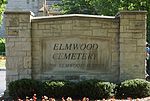Frederic M. Sibley Lumber Company Office Building
Defunct forest products companies of the United StatesFruehauf Trailer CorporationMichigan State Historic SitesNational Register of Historic Places in DetroitNeoclassical architecture in Michigan ... and 4 more
Office buildings completed in 1917Office buildings in DetroitOffice buildings on the National Register of Historic Places in MichiganUnused buildings in Detroit

The Frederic M. Sibley Lumber Company Office Building is an office building located at 6460 Kercheval Avenue in Detroit, Michigan. It was designated a Michigan State Historic Site in 1989 and listed on the National Register of Historic Places in 1991. The building is known for being the beginning of a major trailer manufacturing company.
Excerpt from the Wikipedia article Frederic M. Sibley Lumber Company Office Building (License: CC BY-SA 3.0, Authors, Images).Frederic M. Sibley Lumber Company Office Building
Kercheval Avenue, Detroit
Geographical coordinates (GPS) Address Nearby Places Show on map
Geographical coordinates (GPS)
| Latitude | Longitude |
|---|---|
| N 42.353055555556 ° | E -83.013611111111 ° |
Address
Kercheval Avenue 6460
48207 Detroit
Michigan, United States
Open on Google Maps








